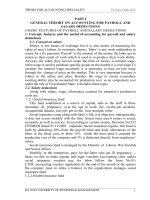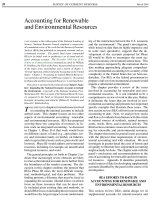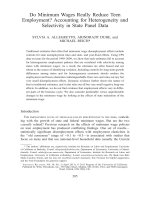Ch05 accounting for state and local government
Bạn đang xem bản rút gọn của tài liệu. Xem và tải ngay bản đầy đủ của tài liệu tại đây (343.78 KB, 42 trang )
Chapter 5: An Introduction to
Accounting for State and Local
Governmental Units
Governmental: Objectives
1. Learn about the historical development of
accounting principles for state and local
governmental units.
2. Understand the need for fund accounting and its
basic premises.
3. Perform transaction analysis using proprietary
and governmental accounting models.
4. Recognize various fund categories, as well as
their measurement focus and basis of accounting.
Objectives (cont.)
5. Review basic governmental accounting
principles.
6. Learn about the contents of a governmental
entity's comprehensive annual financial report.
An Introduction to Accounting for State and Local
Governmental Units
1: History
Governmental Entity
• Popular election of officers or appointment by
officials of one or more state or local
governments
• Potential for unilateral dissolution by
government
– Net assets revert to government
• Power to enact or enforce a tax
Developing Standards
• Municipal Finance Officers Association
• Governmental Accounting, Auditing and Financial
Reporting, 1968
• AICPA
• Audits of State and Local Governmental Units, 1974
• National Council on Governmental Accounting
• Governmental Accounting and Financial Reporting
Principles (beginning 1979)
• Governmental Accounting Standards Board
• GASB Statements (beginning 1984)
• Codification (1985, updated continually)
Hierarchy of GAAP
GAAP for local and state governmental
accounting:
1. GASB Statements and Interpretations
2. GASB Technical Bulletins
3. Consensus positions of GASB's Emerging
Issues Task Force
4. Implementation Guides
5. Other accounting literature
An Introduction to Accounting for State and Local
Governmental Units
2: Fund Accounting
Accounting for Governments
Focus on continuing ability to fund and provide
goods and services
– Not profit
Types of activities
1. Business type activities
• Provide services or goods to users for fees
2. General governmental activities
• Provide services or goods to citizens
without regard for ability to pay
Fund (def.)
"a fiscal or accounting entity with a self balancing
set of accounts recording cash and other …
balances, and changes therein, which are
segregated for the purpose of carrying on
specific activities…" [GASB Codification]
Groups of funds:
– Proprietary funds
– Governmental funds
– Fiduciary funds
Fund Accounting
Each fund has
• Accounting equation
• Journals, ledgers and other records
• Financial statements
A single governmental unit, e.g., one city, has
multiple funds each with their own financial
statements. There is a comprehensive report.
Proprietary Fund Model
Current assets
+ noncurrent assets
- current liabilities
- noncurrent liabilities
= net assets
CA + NCA – CL – NCL = Net assets
Accounting is similar to business enterprises.
Governmental Fund Model
Current assets
– current liabilities
= fund balance
CA – CL = Fund Balance
Accounting focuses on current financial resources.
Expenditures reflect the use of working capital, instead
of expenses which focus on consumption of resources.
General FA and LTD
General fixed assets (FA) are not recorded in
governmental funds.
– General fixed asset and depreciation records
are maintained separately
General long term debt (LTD) is not recorded in
governmental funds.
– Separate records are also kept
Both are reported in the government-wide
statements
An Introduction to Accounting for State and Local
Governmental Units
3: Transaction Analysis
Transactions
1. Borrowed $75 by issuing a 3-year note.
2. Purchased equipment costing $30 for cash.
3. Sold a fully depreciated truck costing $80, with
a residual value of $10 for $8 cash.
4. Computed current depreciation as $15.
5. Borrowed $30 on a six month note.
Using Proprietary Fund Model
Model: CA + NCA – CL – NCL = Net Assets
1 Borrowed long term
CA
75
NCA
CL
NCL
75
Net
Assets
2 Bought equipment
3 Sold truck
4 Depreciation
5 Borrowed short term
(30)
8
30
30
(10)
(15)
30
(2)
(15)
Using Governmental Fund Model
Model: CA – CL = Fund balance
Fund
CA
CL balance
1 Borrowed long term
75
75
2 Bought equipment
(30)
(30)
3 Sold truck
8
8
4 Depreciation
5 Borrowed short term
30
30
• The long term borrowing is a source of current financial
resources, as is the sale of the truck.
• Acquisition of equipment uses current financial resources
An Introduction to Accounting for State and Local
Governmental Units
4: Fund Categories
Proprietary Fund Types
1. Internal service funds
– Provide goods or services on a business type
basis primarily for internal customers
• For departments and agencies of that
government
• Motor pools, central printing
2. Enterprise funds
– Provide goods or services on a business type
basis primarily for external customers
• For citizens and others
• Utilities, trash service, mass transit
Governmental Fund Types
1. Special revenue funds
– General governmental financial resources
restricted for specific purposes
2. Permanent funds
– Resources are restricted but earnings benefit
government or citizens
3. Capital projects funds
– Resources used to construct or acquire
major governmental fixed assets
Governmental Funds (cont.)
4. Debt service funds
– Resources to be used to pay principle,
interest and charges on long term debt
5. General fund
– Working capital available for general
governmental use
• Governmental offices, police, fire, library
Fiduciary Fund Types
Basic proprietary model:
CA + NCA – CL – NCL = Net Assets
1. Pension trust funds
2. Investment trust funds
3. Private purpose trust funds
An abbreviated model:
CA = CL
4. Agency funds
Apply Model to Specific Funds
1.
2.
3.
4.
5.
6.
Issued general obligation bonds, par value of $3,000, at 101
to finance construction of a government office building.
Transferred the premium on the bonds to the fund used to
account for payment of principal and interest on the
bonds.
Incurred and paid construction costs of $125 on the
building.
Levied and collected sales taxes restricted to use for
economic development, $60.
Paid general governmental employees’ salaries, $450.
Another $50 of salaries accrued but has not been paid.
Borrowed $7,500 on a six-month note to finance general
operating costs of the government.
Transactions in Governmental
Type Funds
Model: CA – CL = Fund balance
Specific Fund:
1Capital projects fund
2a Capital projects fund
2b Debt service fund
3 Capital projects fund
4 Special revenue fund
5 General fund
6 General fund
CA
3,030
(30)
30
(125)
60
(450)
1,500
CL
50
1,500
Fund
balance
3,030
(30)
30
(125)
60
(500)









